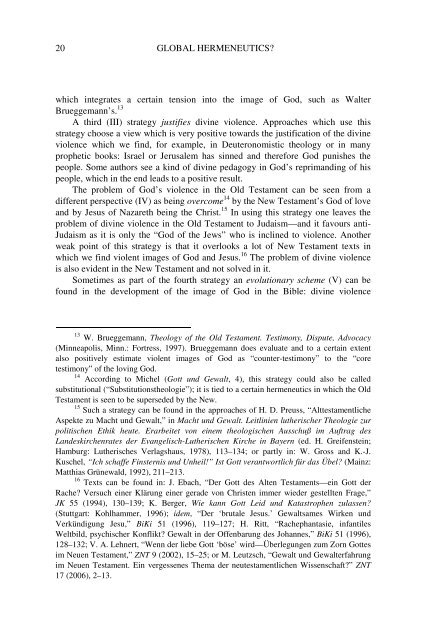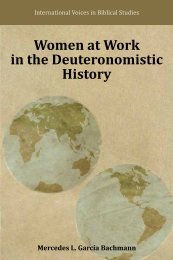Global Hermeneutics? - International Voices in Biblical Studies ...
Global Hermeneutics? - International Voices in Biblical Studies ...
Global Hermeneutics? - International Voices in Biblical Studies ...
Create successful ePaper yourself
Turn your PDF publications into a flip-book with our unique Google optimized e-Paper software.
20 GLOBAL HERMENEUTICS?<br />
which <strong>in</strong>tegrates a certa<strong>in</strong> tension <strong>in</strong>to the image of God, such as Walter<br />
Brueggemann’s. 13<br />
A third (III) strategy justifies div<strong>in</strong>e violence. Approaches which use this<br />
strategy choose a view which is very positive towards the justification of the div<strong>in</strong>e<br />
violence which we f<strong>in</strong>d, for example, <strong>in</strong> Deuteronomistic theology or <strong>in</strong> many<br />
prophetic books: Israel or Jerusalem has s<strong>in</strong>ned and therefore God punishes the<br />
people. Some authors see a k<strong>in</strong>d of div<strong>in</strong>e pedagogy <strong>in</strong> God’s reprimand<strong>in</strong>g of his<br />
people, which <strong>in</strong> the end leads to a positive result.<br />
The problem of God’s violence <strong>in</strong> the Old Testament can be seen from a<br />
different perspective (IV) as be<strong>in</strong>g overcome 14 by the New Testament’s God of love<br />
and by Jesus of Nazareth be<strong>in</strong>g the Christ. 15 In us<strong>in</strong>g this strategy one leaves the<br />
problem of div<strong>in</strong>e violence <strong>in</strong> the Old Testament to Judaism—and it favours anti-<br />
Judaism as it is only the “God of the Jews” who is <strong>in</strong>cl<strong>in</strong>ed to violence. Another<br />
weak po<strong>in</strong>t of this strategy is that it overlooks a lot of New Testament texts <strong>in</strong><br />
which we f<strong>in</strong>d violent images of God and Jesus. 16 The problem of div<strong>in</strong>e violence<br />
is also evident <strong>in</strong> the New Testament and not solved <strong>in</strong> it.<br />
Sometimes as part of the fourth strategy an evolutionary scheme (V) can be<br />
found <strong>in</strong> the development of the image of God <strong>in</strong> the Bible: div<strong>in</strong>e violence<br />
13 W. Brueggemann, Theology of the Old Testament. Testimony, Dispute, Advocacy<br />
(M<strong>in</strong>neapolis, M<strong>in</strong>n.: Fortress, 1997). Brueggemann does evaluate and to a certa<strong>in</strong> extent<br />
also positively estimate violent images of God as “counter-testimony” to the “core<br />
testimony” of the lov<strong>in</strong>g God.<br />
14 Accord<strong>in</strong>g to Michel (Gott und Gewalt, 4), this strategy could also be called<br />
substitutional (“Substitutionstheologie”); it is tied to a certa<strong>in</strong> hermeneutics <strong>in</strong> which the Old<br />
Testament is seen to be superseded by the New.<br />
15 Such a strategy can be found <strong>in</strong> the approaches of H. D. Preuss, “Alttestamentliche<br />
Aspekte zu Macht und Gewalt,” <strong>in</strong> Macht und Gewalt. Leitl<strong>in</strong>ien lutherischer Theologie zur<br />
politischen Ethik heute. Erarbeitet von e<strong>in</strong>em theologischen Ausschuß im Auftrag des<br />
Landeskirchenrates der Evangelisch-Lutherischen Kirche <strong>in</strong> Bayern (ed. H. Greifenste<strong>in</strong>;<br />
Hamburg: Lutherisches Verlagshaus, 1978), 113–134; or partly <strong>in</strong>: W. Gross and K.-J.<br />
Kuschel, “Ich schaffe F<strong>in</strong>sternis und Unheil!” Ist Gott verantwortlich für das Übel? (Ma<strong>in</strong>z:<br />
Matthias Grünewald, 1992), 211–213.<br />
16 Texts can be found <strong>in</strong>: J. Ebach, “Der Gott des Alten Testaments—e<strong>in</strong> Gott der<br />
Rache? Versuch e<strong>in</strong>er Klärung e<strong>in</strong>er gerade von Christen immer wieder gestellten Frage,”<br />
JK 55 (1994), 130–139; K. Berger, Wie kann Gott Leid und Katastrophen zulassen?<br />
(Stuttgart: Kohlhammer, 1996); idem, “Der ‘brutale Jesus.’ Gewaltsames Wirken und<br />
Verkündigung Jesu,” BiKi 51 (1996), 119–127; H. Ritt, “Rachephantasie, <strong>in</strong>fantiles<br />
Weltbild, psychischer Konflikt? Gewalt <strong>in</strong> der Offenbarung des Johannes,” BiKi 51 (1996),<br />
128–132; V. A. Lehnert, “Wenn der liebe Gott ‘böse’ wird—Überlegungen zum Zorn Gottes<br />
im Neuen Testament,” ZNT 9 (2002), 15–25; or M. Leutzsch, “Gewalt und Gewalterfahrung<br />
im Neuen Testament. E<strong>in</strong> vergessenes Thema der neutestamentlichen Wissenschaft?” ZNT<br />
17 (2006), 2–13.




